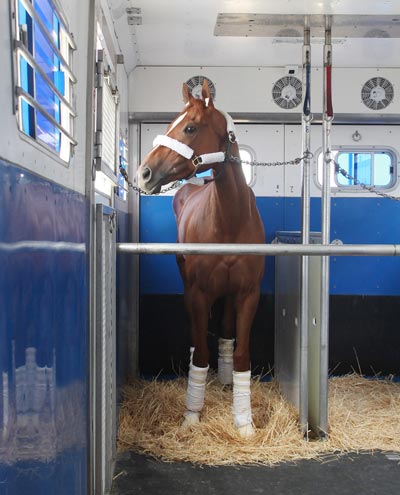

 Stall and-a-half (Approximately 4’ wide)
Stall and-a-half (Approximately 4’ wide)
 Box Stall (Approximately 8’ wide; 10’x10’ diagonally)
Box Stall (Approximately 8’ wide; 10’x10’ diagonally)In addition to taking good care of your horse, we at Brook Ledge are concerned that your horse travel in the optimum stall space to reduce stress during the trip. Although we supply the standard stall alternatives (stall and a 1/2 or box stall), we urge our customers to consider the box stall option. Industry research and articles have noted the health advantages of box stalls for transporting horses. Horses shipped in box stalls arrive fresher and are less inclined to have any health issues related to shipping. Most of the top stables and trainers ship their horses in box stalls. Their experience has shown them that even though the initial expense is higher, the actual cost is lower due to virtually no sickness or 'down time'. For all trips across the country we only utilize box stalls.
Please note the following articles...
“They found that the cross-tied horses had larger increases of selected stress parameters 24 hours following transportation that did horses traveling loose without being tied. Dr. Stull and Dr. Rodiek recommend that a small box stall is preferable to cross-tying during long-distance road transport. And if you use a commercial carrier to ship a horse across the country, ’pay the extra amount to get a box stall. It will be worth it when your horse arrives less stressed and ready to compete’.”
Pg. 11 Also, see page head for Head Posture.
Read more...
This article noted the advantages of shipping a horse with a licensed carrier, which means its drivers are qualified to operate the rigs and its hours are logged and tracked.
EQUUS magazine reported on an University of California-Davis study that found that horses who were cross-tied for the duration of a long trailer ride had dramatic physiological changes to their immune system, leaving them more susceptible to illness after their journey. The study's author recommended allowing a horse to stand untied in a trailer so that he can drop his head to below withers-height.
Danny Shifflett, Manager of William S. Farish's Lane's End Texas in Hempstead. Shifflett has been in the horse business for more that 30 years and has found that many sickness problems related to shipping can be avoided if horses have good ventilation and plenty of water during the trip. "Give them plenty of room and absolutely give them a box stall for anything over 300 or 400 miles."
"It doesn't matter if it's a broodmare, a racehorse or a yearling, shipping is stressful to them, and you don't want to compromise them by starting with a problem." Consider a mares overall condition before subjecting her to long distance travel. For example, Mathews said he does not like to see a mare with chronic laminitis have to stand on a Van for such a journey. "The stress of the trip can be tough on them," says Mathews.
"If you have any feet or lameness issues, certainly give her a box stall to encourage her to lie down if she will. Just give her that option."
Shipping fever is a respiratory infection that affects the chest cavity and the lungs. It occurs most often during transport because of the stress of travel combined with the fact that air quality declines inside horse trailers if they arenât properly ventilated and horses don't have room to stretch out their head and necks. Because horses normally do not carry their head above the withers, cross-tying a horse in that position doesnât allow him to clear their respiratory track effectively.
"Thousands of horses travel every year and never have a problem," said Lewis (Jordan Lewis, DVM, of Palm Beach Equine Medical Center in Wellington, Fla). "But if you have a horse at increased risk, ship them in a box stall, make sure they're well vaccinated, and if you have a horse that's more prone, think about an immune stimulant."
This article noted the health and safety concerns in transporting horses. In addition to the important variables of temperature, ventilation and food, the article recommended the box stall to allow the horse freedom of movement.